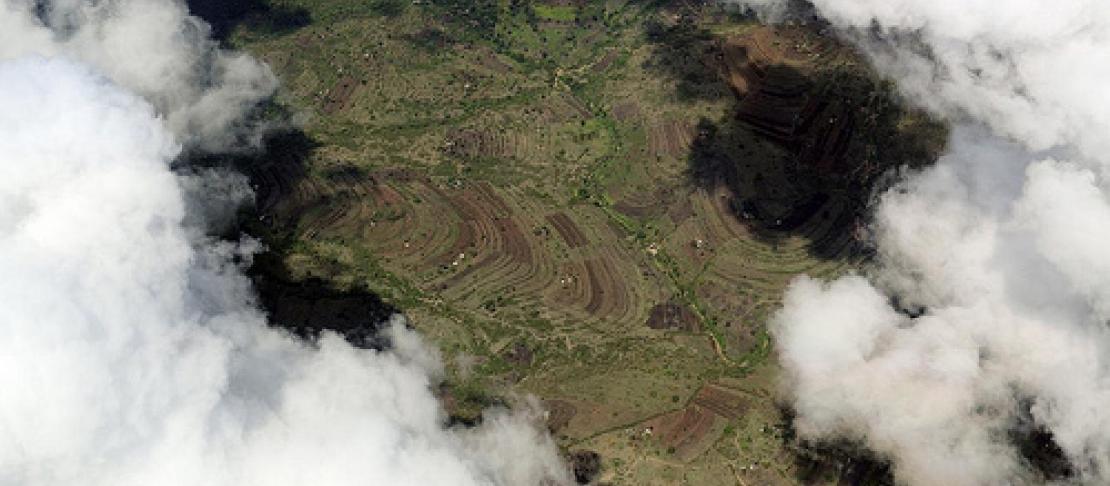Cloudy, with a chance of drought

Wheat yields could drop by 60% or rise by 40% in a 4C warmer world, according to the 2007 report of the Intergovernmental Panel on Climate Change (PDF). How can science manage such huge levels of uncertainty, so as to assist rather than paralyze policy decisions? Part of the answer lies in improving how we estimate uncertainties and risks, as multi-disciplinary scientific programs like EQUIP (at the university of Leeds) are doing. Another part lies in better communication between science and policy.
The role of social and decision sciences in communicating uncertain climate risks, an article by Nick Pidgeon and Baruch Fischhoff, cuts through the swathe of opinions on communicating climate risks to the evidence on what works. The authors broadly condone the views of the Stern Review on the Economics of Climate Change, and the National Academies, that we should focus on the risks, costs and benefits of specific pathways of action, rather than on the persistent uncertainties around climatic drivers, processes and impacts. This focus enables decisions, rather than inviting endless delays while we seek greater certainty.
Pidgeon and Fischhoff offer some useful pointers from empirical research. An interesting one is that non-scientists are better able to make decisions when uncertainties are expressed in numbers rather than verbal qualifiers like ‘probable’ or ‘unlikely’. The authors note that we lack rigorous research on the effectiveness of IPCC communications. Nonetheless recent commissioned and independent reviews of the IPCC have urged much more consistent language for reporting types and levels of uncertainty.
Importantly, different decision-makers need to understand different aspects of climate risks, at different scales of time and space. A company that sources agricultural commodities globally may want to know the likelihood that yield failures in various regions will be correlated. An individual farmer may be most concerned with the chance of dry spells or a late start to this year’s growing season. Information on specific risks is much more useful, however, if decision-makers can link it into their own mental models of underlying processes and causes of uncertainty.
Points like these lead Pidgeon and Fischhoff to propose a generic approach of ‘strategic listening’ and ‘strategic organization’. Strategic listening involves shaping communications around stakeholders’ expressions of their own options for action and needs for knowledge. To do this effectively requires strategic organization: employing a team that includes not only science managers and subject-matter experts (climatologists, agriculturalists etc), but also social and communications scientists who can design evidence-based modes of communication, and decision scientists who can bridge between policy and science.
Multi-skilled teams imply a reallocation of science budgets. A group of professionals in Life Cycle Analysis recently proposed a ‘three-thirds principle’: to spend a third of project resources on working with stakeholders to develop shared understanding of the issues and objectives, a third on assisting them to interpret and apply results, and only a third on the scientific research itself. Arguably any scientific organisation that is concerned with informing policy should consider the pros and cons of this principle – and the radical reconfiguration it may demand.
Links
- IPCC Fourth Assessment Report: Climate Change 2007. Chapter 5: Food, Fibre, and Forest Products (PDF)
- End-to-end quantification of uncertainty for impacts prediction (EQUIP)
- Fully EQUIPed - how climate scientists are quantifying uncertainty . Natural Environment Research Council, UK. 17 June 2011.
- Pidgeon, N. and Fischhoff, B. 2011. The role of social and decision sciences in communicating uncertain climate risks. Nature Climate Change 1: 35-41.
- Stern Review on the Economics of Climate Change. 2006.
- Informing Decisions in a Changing Climate. Panel on Strategies and Methods for Climate-Related Decision Support; National Research Council. 2009.
- Climate Change Assessments, Review of the Processes & Procedures of the IPCC. 2010.
- Jonassen, R. & Pielke, R., 2011. Improving conveyance of uncertainties in the findings of the IPCC. Climatic Change 4: 745-753. DOI: 10.1007/s10584-011-0185-7
- Fullana i Palmer. P., Puig, R., Bala, A., Baquero G., Riba J. and Raugei M. 2011. From Life Cycle Assessment to Life Cycle Management: A Case Study on Industrial Waste Management Policy Making. Journal of Industrial Ecology. 15(3):458-474. DOI: 10.1111/j.1530-9290.2011.00338.x
This is the November installation of AgClim Letters, a monthly e-bulletin on science and policy written by Sonja Vermeulen, Head of Research for CCAFS. Sign up to receive AgClim Letters bulletin and read past bulletins Your comments are welcome below.